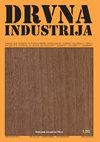醋酸酐预浸渍和点火时间对木塑复合材料机械和物理特性的影响
IF 0.8
4区 农林科学
Q4 MATERIALS SCIENCE, PAPER & WOOD
引用次数: 0
摘要
本研究旨在评估不同的预浸渍时间(PITs)(60、180 和 300 分钟)、加热或反应时间(H/RTs)(60、90 和 120 分钟)以及木粉(WF)化学改性对木塑复合材料(WPCs)机械和物理性能的影响。研究采用乙酰化山毛榉(Fagus orientalis L.)粉作为填料,聚丙烯(PP)作为基体相,通过熔融复合和注塑成型生产出木塑复合材料样品。所得复合材料经过了物理和机械性能测试。研究结果表明,除弯曲模量外,PIT 为 60 分钟、H/RT 为 60 分钟的乙酰化木材制成的木塑具有最高的机械性能。此外,吸水率(WA)在 PITs-H/RTs 组合为 60-120 分钟时最低,而厚度膨胀率(TS)在 PITs-H/RTs 组合为 300-60 分钟时最低。同时利用预浸渍和反应时间对物理和机械性能产生了协同效应。因此,木粉的化学改性和适当反应时间的应用改善了界面粘附性,从而提高了木塑复合材料的整体性能。本文章由计算机程序翻译,如有差异,请以英文原文为准。
Utjecaj predimpregnacije anhidridom octene kiseline i vremena zagrijavanja na mehanička i fizička svojstva drvno-plastičnih kompozita
This research aimed to assess the influence of different pre-impregnation times (PITs) (60, 180, and 300 min), heating or reaction times (H/RTs) (60, 90, and 120 min), and chemical modification of wood flour (WF) on the mechanical and physical properties of wood-plastic composites (WPCs). The study employed acetylated beech (Fagus orientalis L.) flour as the filler and polypropylene (PP) as the matrix phase producing of WPC samples through melt compounding and injection molding. The resulting composites underwent testing for their physical and mechanical properties. The findings revealed that WPCs derived from acetylated wood with PITs of 60 min and H/RTs of 60 min exhibited the highest mechanical properties, except for the bending modulus. Moreover, the lowest water absorption (WA) was observed in the PITs-H/RTs combination of 60-120 min, while the lowest thickness swelling (TS) occurred in the PITs-H/RTs combination of 300-60 min. The simultaneous utilization of pre-impregnation and reaction times demonstrated a synergistic effect on the physical and mechanical properties. Consequently, the chemical modification of wood flour and the application of suitable reaction times improved the interfacial adhesion, thereby enhancing the overall performance of the WPCs.
求助全文
通过发布文献求助,成功后即可免费获取论文全文。
去求助
来源期刊

Drvna Industrija
MATERIALS SCIENCE, PAPER & WOOD-
CiteScore
1.80
自引率
9.10%
发文量
32
审稿时长
>12 weeks
期刊介绍:
"Drvna industrija" ("Wood Industry") journal publishes original scientific and review papers, short notes, professional papers, conference papers, reports, professional information, bibliographical and survey articles and general notes relating to the forestry exploitation, biology, chemistry, physics and technology of wood, pulp and paper and wood components, including production, management and marketing aspects in the woodworking industry.
 求助内容:
求助内容: 应助结果提醒方式:
应助结果提醒方式:


